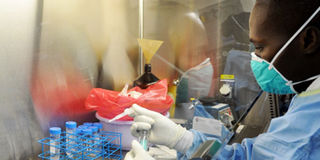WHO report reveals higher global burden of tuberculosis

A health worker looks at samples of sputum to test for TB at the TB centre at Mulago hospital. Photo by Rachel Mabala
What you need to know:
The report, however, underlines that a staggering number of lives are being lost to a curable disease and confirms TB is the second biggest killer disease from a single infectious agent.
The World Health Organisation (WHO) has revised upwards, by almost 500,000, the estimated number of people who have tuberculosis (TB) globally.
In its 2014 global TB report, WHO says last year, about nine million people developed TB around the world, up from 8.6 million in 2012.
However, the number of people dying from the disease continued to decline, it added.
“Following a concerted effort by countries, by WHO and by multiple partners, investment in national surveys and routine surveillance efforts has substantially increased. This is providing us with better data and bringing us closer to understanding the true burden of tuberculosis,” said Dr Mario Raviglione, director of the global TB programme at WHO.
The report, however, underlines that a staggering number of lives are being lost to a curable disease and confirms TB is the second biggest killer disease from a single infectious agent.
In addition, around three million people who fall ill from TB are still being missed by health systems each year, either because they are not diagnosed, or because they are diagnosed but not reported.
In the long-term, WHO says deaths from TB have dropped by 45 per cent since 1990, while the number of people developing the disease is declining by an average 1.5 per cent a year.
The report says about 37 million lives have been saved through effective diagnosis and treatment since 2000.
Drug resistant TB
The report shows multi-drug-resistant TB (MDR-TB) remains a global threat, with an estimated 480,000 new cases registered in 2013. MDR-TB is more difficult and expensive to treat, compared to ordinary TB.
“The progress that has been made in combatting MDR-TB has been hard won and must be intensified. Containing and reversing the epidemic requires immediate and sustained efforts by all stakeholders,” said Dr Karin Weyer, coordinator for laboratories, diagnostics and drug resistance at WHO.
Dr Weyer says with improved diagnostic tools, detection and treatment become easy.
Uganda is one of 22 countries with a high burden of TB. Statistics from WHO show about 60,000 new infections occur every year in Uganda, but 31 per cent of these are not diagnosed and therefore not treated.




